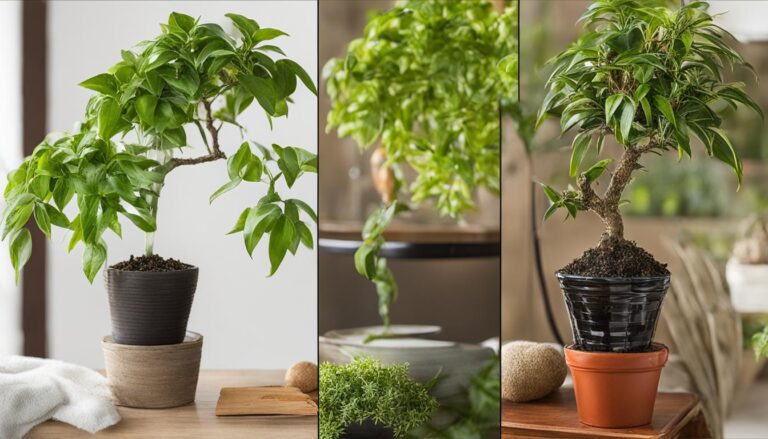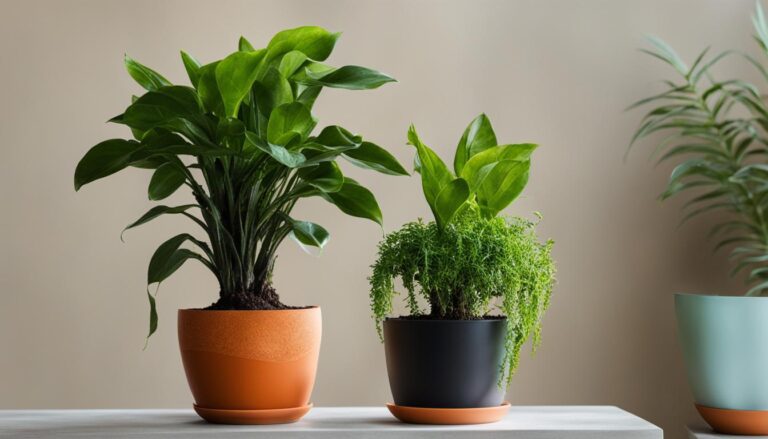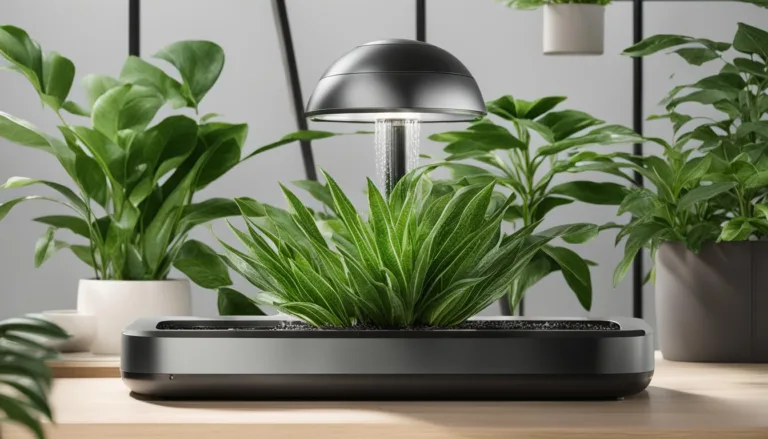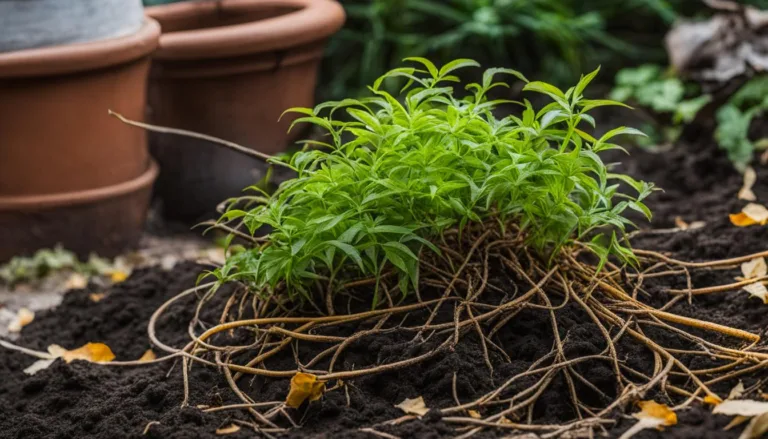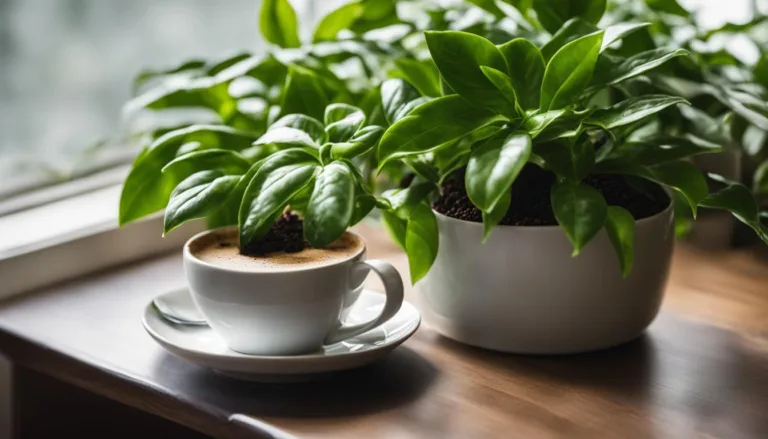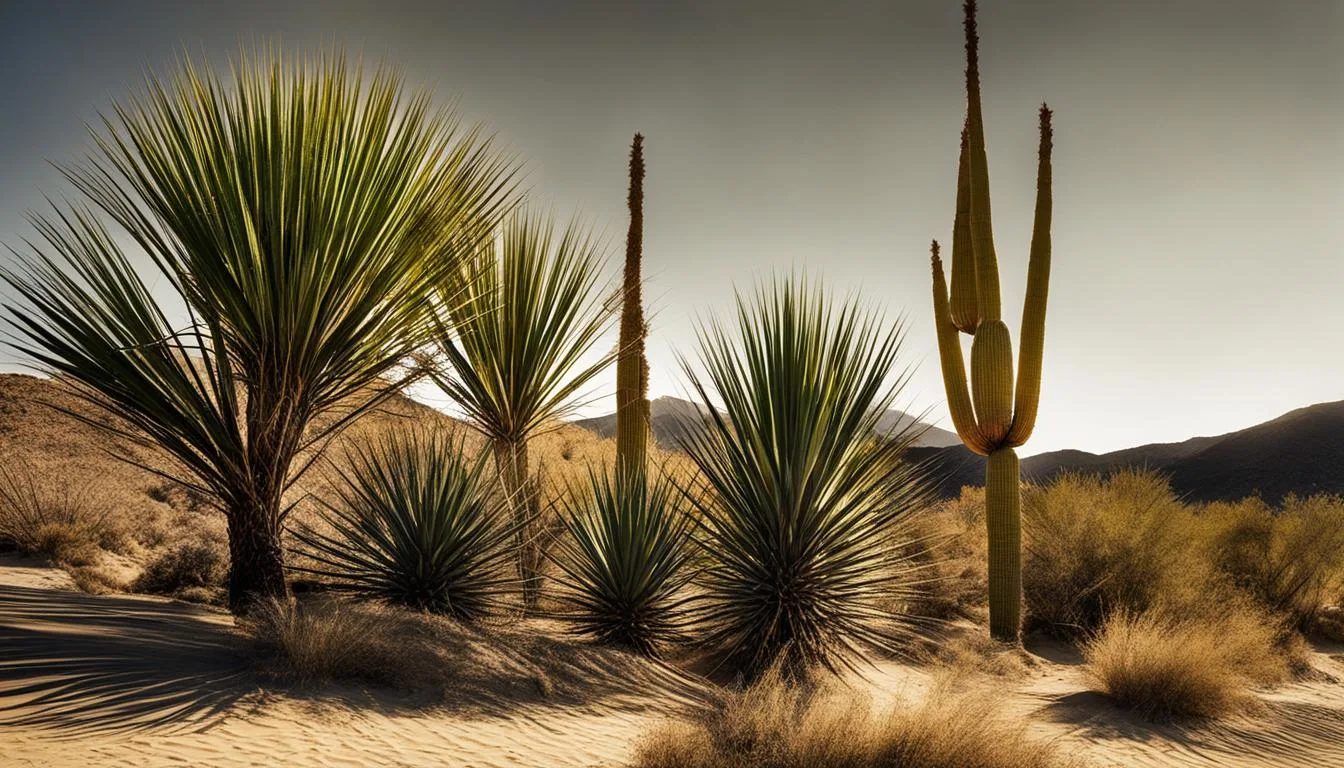
Yucca plants are a stunning addition to any garden or home. These resilient plants, native to the American Southwest, Mexico, and the Caribbean, offer a touch of desert beauty wherever they are grown.
Whether you choose to keep them indoors as houseplants or plant them outside in your garden, yucca plants require some care and maintenance to thrive.
When it comes to caring for yucca plants, it’s important to understand their unique needs. From proper watering and lighting to maintenance and pruning, here’s a guide to help you keep your yucca plants healthy and vibrant.
Key Takeaways:
- Yucca plants are visually interesting and can be grown indoors or outdoors.
- They are drought-tolerant and can withstand cold temperatures.
- Yucca plants have invasive root systems and are toxic to pets.
- Proper watering, lighting, and maintenance are essential for their care.
- Regular pruning and monitoring for pests and diseases are also important.
Growing Yucca Plants
When it comes to growing yucca plants, you’ll find that they are relatively easy to care for and can thrive in dry, sandy regions like the desert. These plants prefer well-draining soil and full sun exposure. Their ability to withstand heat, drought, and salt spray makes them perfect for arid climates.
To ensure successful growth, it’s important to provide good air circulation by planting yucca plants in an open area. This helps prevent fungal diseases from taking hold.
Watering yucca plants correctly is crucial for their survival. During the spring and summer growing seasons, yuccas should be watered once a week, allowing the soil to dry out between waterings.
This mimics their natural environment and prevents overwatering, which can lead to root rot. In the winter, reduce watering to once every few weeks. Remember, these plants thrive in dry conditions, so be cautious not to overdo it with the watering can!
While yucca plants generally require minimal maintenance, they may need occasional pruning if they outgrow their space. Pruning can be done in early spring by cutting the plant above ground, and the rooted end of the trunk can be repotted to propagate a second plant.
Yucca plants may also produce offshoots, known as “pups,” which can be separated and replanted to create new plants. It’s important to handle yucca plants with care during pruning, as their leaves are sharp and can cause injury.
| Prefers | Avoids |
|---|---|
| Bright, indirect sunlight | Excessive direct sunlight |
| Well-draining soil | Waterlogged soil |
| Air circulation | High humidity |
Overall, growing yucca plants can be a rewarding experience. With their ability to thrive in harsh conditions and their unique visual appeal, they can make a stunning addition to any garden or indoor space. By providing the right conditions, proper watering, and occasional pruning, you can ensure the health and longevity of your yucca plants for years to come.
Yucca Plant Maintenance and Pruning
Proper maintenance and occasional pruning are essential for keeping yucca plants healthy and visually appealing. Regular pruning helps control the plant’s size and shape, while also promoting new growth.
When it comes to pruning yucca plants, it’s best to do so in early spring before the growing season begins. Start by cutting the plant above the ground, leaving a bare trunk. This helps maintain a tidy appearance and prevents the plant from becoming too top-heavy.
Additionally, the removed trunk can be repotted to propagate a second yucca plant. Simply plant the rooted end of the trunk in a new pot with well-draining soil, water it lightly, and place it in a bright area with indirect sunlight. With proper care, the propagated plant should take root and begin to grow within a few weeks.
Yucca plants may also produce “pups” or offshoots, which are smaller plants that grow from the base of the parent plant. These pups can be separated from the main plant and replanted to create new yucca plants. By carefully cutting away the pup and its attached roots, it can be transplanted into a new pot or garden bed.
Benefits of Pruning:
- Controls the size and shape of the plant
- Promotes new growth and a fuller appearance
- Helps maintain a tidy and visually appealing yucca plant
- Provides opportunities for propagation and creating new plants
| Pruning Guidelines | Description |
|---|---|
| Timing | Prune yucca plants in early spring before the growing season begins. |
| Method | Cut the plant above the ground, leaving a bare trunk. Repot the trunk to propagate a second plant or separate and replant any offshoots. |
| Cautions | Be cautious when pruning yucca plants, as their sharp leaves can cause injury. Use gardening gloves and sharp, clean pruning shears for safe and effective pruning. |
Remember to exercise caution when pruning yucca plants, as their leaves are sharp and can cause injury. Wear gardening gloves and use sharp, clean pruning shears for safe and effective pruning. By following these maintenance and pruning practices, you can keep your yucca plants thriving and looking their best.
Yucca Plant Pests and Diseases
While yucca plants are generally hardy and resistant to pests and diseases, there are a few issues that can arise. Being aware of these potential problems and taking preventive measures can help ensure the health and vitality of your yucca plants.
Pests
One common pest that can affect yucca plants is scale insects. These small, oval-shaped insects attach themselves to the leaves and stems, sucking the sap and causing damage. To combat scale insects, you can use insecticidal soap.
Apply the soap according to the manufacturer’s instructions, making sure to thoroughly coat the affected areas. Repeat the treatment as necessary to completely eliminate the pests. Regularly inspect your yucca plants for signs of scale infestation, such as sticky residue or black mold on the leaves.
Diseases
Yucca plants can also be susceptible to fungal diseases, particularly if they are exposed to high humidity or overwatered. Common fungal diseases that can affect yucca plants include leaf spot and root rot. Leaf spot manifests as black or brown spots on the leaves, while root rot causes the roots to become mushy and discolored.
To prevent fungal diseases, it is important to avoid overwatering your yucca plants and to ensure proper drainage in the soil. Water at the base of the plant and avoid wetting the leaves, as this can create a breeding ground for fungi.
If you notice signs of fungal infection, such as leaf spots or root discoloration, treat the plant with neem oil. Neem oil is a natural fungicide that can help control the spread of fungal diseases.
| Pest/Disease | Symptoms | Treatment |
|---|---|---|
| Scale Insects | Sticky residue, black mold on leaves | Insecticidal soap |
| Leaf Spot | Black or brown spots on leaves | Treat with neem oil |
| Root Rot | Mushy, discolored roots | Improve drainage, treat with neem oil |
By being proactive and taking appropriate measures, you can prevent and treat pests and diseases that may affect your yucca plants. Regularly inspect your plants and provide them with the proper care, and you’ll enjoy healthy and vibrant yucca plants in your garden or home.
Yucca Plant Propagation
I’ve always found yucca plants fascinating, and one of the most interesting aspects of these resilient plants is their ability to be propagated in various ways.
Whether you want to expand your yucca collection or share these beautiful plants with friends and family, there are a few methods you can use to propagate yucca plants.
Green Pup Shoots
A common method of propagating yucca plants is by cutting away a green pup shoot that grows along the base of the plant. This shoot can be carefully separated from the parent plant, ensuring that it has some roots attached.
The pup can then be replanted in a suitable potting mix to establish itself as a new plant. This method allows for easy and efficient propagation, as the pup already has a head start with its own roots.
Dividing Rhizomes
Another way to propagate yucca plants is by dividing their rhizomes. Rhizomes are underground stems that produce roots and shoots, and they can be divided to create new plants.
To do this, carefully remove the parent plant from its pot or outdoor location and gently separate the rhizomes. Each divided section can then be planted in a new pot or area, where it will grow into a separate yucca plant.
Seed Propagation
For those who enjoy the challenge of starting plants from seeds, yucca plants can also be propagated through seed propagation. However, this method requires a few additional steps for success.
Yucca seeds need a chilling period to break their dormancy, so they should be refrigerated for a few weeks before planting.
The seeds must be scarified or lightly scratched to enhance germination rates. Once these steps are completed, the seeds can be sown in a well-draining soil mix and kept moist until they germinate.
Overall, yucca plant propagation offers plant enthusiasts an opportunity to expand their collections and share the beauty of these unique plants.
Whether you choose to propagate through green pup shoots, dividing rhizomes, or seed propagation, it’s important to provide the necessary care and attention to ensure the success of your new yucca plants.
Yucca Plant Lighting Requirements
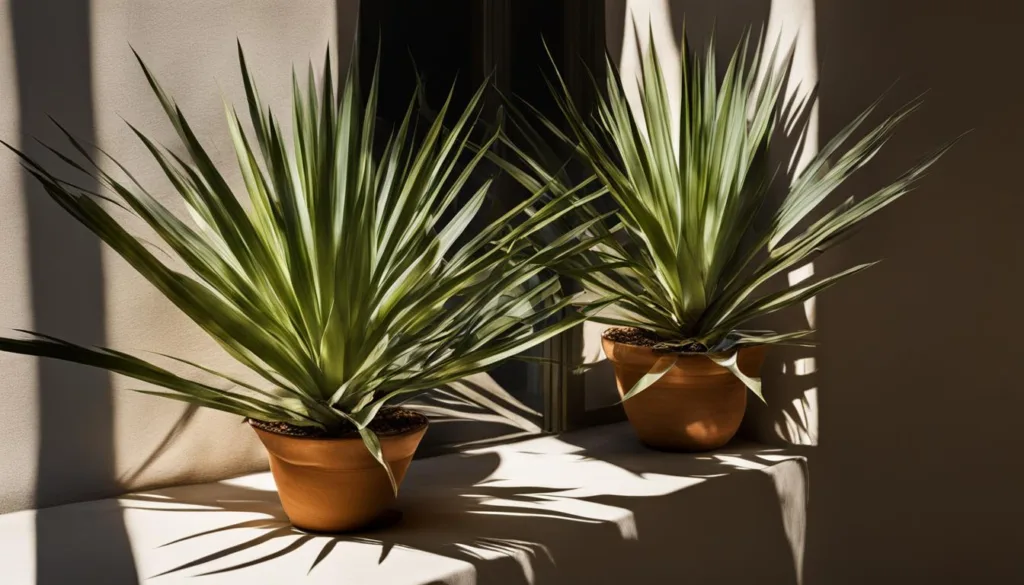
When it comes to yucca plant care, providing the right amount of light is essential for their growth and overall health. Yucca plants thrive in bright, indirect sunlight, making them well-suited for sun-drenched areas like the desert.
They can tolerate some direct sunlight, but it’s important to avoid excessive exposure as it can cause damage to their leaves. Aim to provide your yucca plant with at least 4-6 hours of bright, indirect sunlight per day.
If you’re growing yucca plants indoors, place them near a south-facing window or any window that receives ample sunlight throughout the day.
If natural light is limited, you can use artificial light sources like fluorescent or LED grow lights to supplement the plant’s lighting requirements. Position the lights about 12-18 inches above the plant and keep them on for 12-14 hours a day.
Signs of Inadequate Lighting
Proper lighting is crucial for yucca plants, and inadequate light can lead to various issues. If your yucca plant isn’t getting enough light, it may exhibit the following signs:
- Stretched-out, elongated stems
- Pale or yellowing leaves
- Slow growth or no new growth
- Leaf drop
If you notice any of these symptoms, it’s a clear indication that your yucca plant needs more light. Move it to a brighter location or increase the amount of artificial light it receives.
| Lighting Conditions | Effects on Yucca Plants |
|---|---|
| Bright, indirect sunlight | Optimal growth and health |
| Too much direct sunlight | Leaf damage and burning |
| Insufficient light | Stretched-out stems, pale leaves, slow growth |
| Artificial light | Supplemental light source for indoor yucca plants |
Providing the right lighting conditions is an important aspect of yucca plant care. By ensuring your yucca plant receives adequate light, either natural or artificial, you can promote its growth, vibrant foliage, and overall beauty.
Yucca Plant Watering Requirements
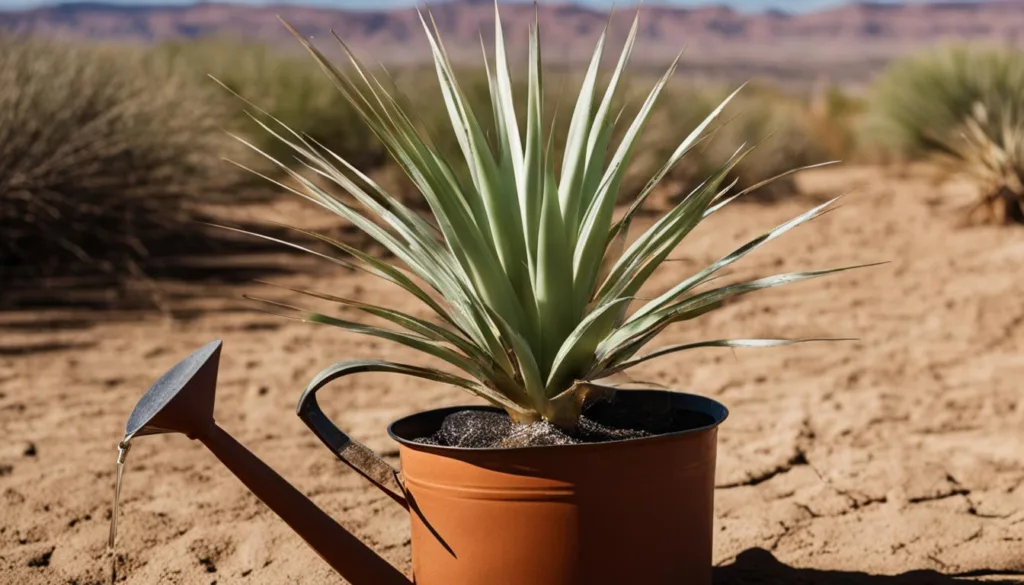
Proper watering is essential for the health and vitality of yucca plants. Understanding their watering requirements will help you maintain a thriving plant.
Yucca plants prefer to be kept on the drier side and can tolerate periods of drought. Overwatering can lead to root rot and other issues, so it’s important to strike the right balance.
During the growing season, which is typically spring and summer, yucca plants should be watered once every 10-14 days. This allows the soil to dry out between waterings, preventing the risk of overwatering.
It’s important to water at the roots and avoid wetting the leaves, as damp foliage can lead to fungal diseases. To ensure proper drainage, make sure the soil has excellent drainage and that the pot or planting area has drainage holes.
Signs of Underwatering and Overwatering
Knowing the signs of underwatering and overwatering can help you adjust your watering routine accordingly. If a yucca plant is underwatered, the leaves may become limp, yellow, or brown.
The plant may also show signs of wilting or drooping. On the other hand, overwatering can cause the leaves to become mushy or discolored. The plant may also develop root rot, which can lead to a foul smell and stunted growth.
It’s important to observe and monitor your yucca plant for any signs of water stress or overwatering. Adjust your watering schedule as needed based on the condition of the plant and the moisture level of the soil.
| Watering Frequency | Season | Guidelines |
|---|---|---|
| Every 10-14 days | Spring and Summer | Allow soil to dry out between waterings |
| Every 3-4 weeks | Dormant Season (Winter) | Decrease watering frequency |
Yucca Plant Temperature Requirements
When it comes to yucca plant temperature requirements, these versatile plants can tolerate a wide range of temperatures. However, they do have their preferences. Yucca plants thrive in warm and sunny environments, making them a perfect fit for desert regions.
They prefer temperatures between 60°F to 80°F, but they can handle lows as low as 30°F and highs as high as 90°F. It’s important to note that prolonged exposure to extreme temperatures can harm the plant, so it’s best to protect them from frost in colder regions.
Yucca plants are naturally adapted to survive in the desert, where temperatures can fluctuate drastically. They have built-in mechanisms that allow them to tolerate both hot and cold conditions.
Their fleshy leaves and thick, waxy coating help them retain moisture during hot weather, while their deep root systems help them access water even in dry soil. These adaptations make yucca plants resilient and able to withstand temperature variations.
To ensure the optimal growth and health of your yucca plant, it’s important to monitor the temperature around the plant and make adjustments when necessary.
If you live in an area with extreme temperature fluctuations, consider providing some additional protection for your yucca plants during the coldest or hottest times of the year. This could include using plant covers or moving potted yuccas to more sheltered locations.
Yucca Plant Temperature Guidelines
| Temperature Range | Yucca Plant Response |
|---|---|
| 60°F to 80°F | Optimal temperature range for yucca plant growth |
| Below 30°F | Prolonged exposure can harm the plant, protect from frost |
| Above 90°F | Prolonged exposure can harm the plant, provide shade or shelter |
By considering the temperature requirements of your yucca plants and providing them with the right conditions, you can ensure their long-term health and enjoyment.
Whether you’re growing them indoors as houseplants or outdoors in your garden, maintaining a suitable temperature range will help your yucca plants thrive and continue to beautify your space.
Yucca Plant Humidity Requirements
Proper humidity levels are crucial for the optimal growth and health of yucca plants. While these plants can tolerate low humidity, they benefit from moderate moisture in the air. Maintaining the ideal humidity range of 30% to 50% ensures that yucca plants thrive and avoid stress or diseases.
If the humidity drops below 30%, yucca plants may exhibit signs of distress such as brown tips on the leaves and leaf drop. This can be remedied by increasing the humidity around the plant.
Placing a tray of water near the plant or using a humidifier can effectively raise the humidity levels. However, it’s important to avoid excessive humidity above 50%, as it can lead to fungal diseases and even root rot.
Monitoring and maintaining the humidity level in the environment where yucca plants are kept is essential. By providing adequate moisture without going to extremes, yucca plants can thrive and maintain their vibrant and healthy appearance.
Ideal Humidity Levels for Yucca Plants
| Humidity Level | Effects on Yucca Plants |
|---|---|
| Below 30% | – Brown tips on leaves – Leaf drop – Increased risk of stress |
| 30% to 50% (ideal range) | – Optimal growth and health – Reduced risk of stress and diseases |
| Above 50% | – Increased risk of fungal diseases – Root rot |
By taking into account the humidity requirements of yucca plants and providing the appropriate moisture levels, you can ensure that these beautiful plants thrive and bring desert beauty into your home or garden.
Yucca Plant Soil and Fertilizer Requirements
When it comes to the soil requirements for yucca plants, it’s important to provide them with well-draining soil that is slightly acidic to neutral.
Aim for a pH range of 6.0 to 7.5 to create the ideal growing environment. To improve drainage, consider mixing in sand or perlite into the soil. This will ensure that excess moisture doesn’t accumulate around the roots, which can lead to root rot.
Yucca plants thrive in soil that is rich in organic matter. Incorporating compost or well-rotted manure into the soil will provide the plant with essential nutrients and help it grow strong and healthy.
It’s recommended to do this during the initial planting stage and as a yearly top-dressing. Remember, moderation is key when it comes to fertilization. Over-fertilization can be harmful to yucca plants, so using a balanced fertilizer once a year in the spring or early summer is sufficient.
In summary, yucca plants prefer well-draining soil that is slightly acidic to neutral. Enhance the soil’s drainage by adding sand or perlite, and enrich it with compost or well-rotted manure to provide essential nutrients.
Remember to fertilize the plant once a year to avoid over-fertilization. By meeting these soil and fertilizer requirements, you’ll create an optimal growing environment for your yucca plants.
FAQ
Are yucca plants the same as yuca or cassava plants?
No, yucca plants are not the same as yuca or cassava plants. Yucca plants are ornamental plants, while yuca or cassava plants are edible tubers.
Are yucca plants toxic to pets?
Yes, yucca plants are toxic to pets. It’s important to exercise caution if adding yucca plants to a household with dogs or cats.
How often should yucca plants be watered?
Yucca plants should be watered once a week during the spring and summer growing seasons, allowing the soil to dry out between waterings. In winter, watering should be decreased to once every few weeks.
How should yucca plants be pruned?
Yucca plants can be pruned in early spring by cutting the plant above ground. The rooted end of the trunk can be repotted to propagate a second plant. Yucca plants may also produce “pups” or offshoots that can be separated and replanted to create new plants.
What pests and diseases affect yucca plants?
Scale insects can occasionally be a problem for yucca plants. They can be treated with insecticidal soap. Yucca plants can also be affected by fungal diseases if they are exposed to high humidity or overwatered. Treating the plant with neem oil can help fight fungal diseases.
How can yucca plants be propagated?
Yucca plants can be propagated by cutting away a green pup shoot and replanting it with some of the parent plant’s roots. They can also be propagated by dividing the plant’s rhizomes or by using seeds with a chilling period and scarification process.
What are the lighting requirements for yucca plants?
Yucca plants thrive in bright, indirect sunlight. They should be placed near a window that receives bright, indirect sunlight for most of the day. If natural light is limited, artificial light can be used to supplement the plant’s lighting requirements.
How often should yucca plants be watered?
Yucca plants should be watered once every 10-14 days during the growing season, allowing the soil to dry out between waterings. In the dormant season, watering can be decreased to once every 3-4 weeks.
What temperature range do yucca plants prefer?
Yucca plants prefer temperatures between 60°F to 80°F. They can handle temperatures as low as 30°F and as high as 90°F. However, prolonged exposure to extreme temperatures can harm the plant.
What humidity level do yucca plants require?
Yucca plants prefer humidity levels between 30% to 50%. If the humidity drops below 30%, the plant may show signs of stress, such as brown tips on the leaves and leaf drop. If the humidity is above 50%, it can lead to fungal diseases and root rot.
What are the soil and fertilizer requirements for yucca plants?
Yucca plants prefer well-draining soil that is slightly acidic to neutral, with a pH range of 6.0 to 7.5. Mixing sand or perlite into the soil can improve drainage. Yucca plants benefit from soil that is rich in organic matter, which can be achieved by incorporating compost or well-rotted manure. Regular fertilization with a balanced fertilizer once a year in the spring or early summer is sufficient.

